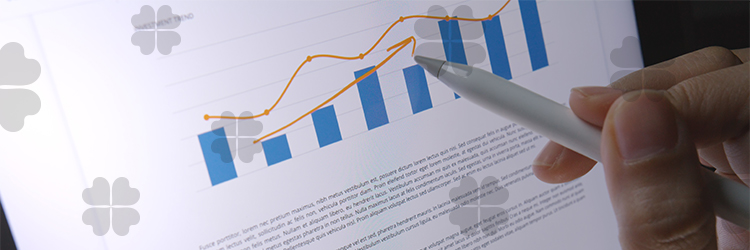Reading stock charts is a crucial skill for anyone interested in the stock market. Understanding these charts allows investors to make informed decisions by analysing price movements, trends, and patterns. So, let’s see how to read stock market charts and use the knowledge to trade profitably.
Topics Covered :
- What is a Stock Chart?
- How to Read Stock Charts?
- Reading Price and Volume in the Right Perspective
- Reading the Trend Line
- Conclusion
What is a Stock Chart?
A stock chart is a crucial tool in the world of investing, providing a visual representation of a stock’s price movements over a specific period. By illustrating historical prices and trading volumes, stock charts help investors identify trends, patterns, and potential trading opportunities. There are several types of stock charts, each offering unique insights into the stock market’s behaviour.
-
-
Line Charts
Line charts are the simplest form of stock charts. They plot the closing prices of a stock over a set period, connecting these points with a continuous line. This chart type is ideal for a quick overview of the stock’s general price direction. However, line charts do not provide detailed information about intraday price movements, such as the opening price, highest price, and lowest price of the day.
For example, if you are looking at a line chart of a popular stock over the past year, you will see how the closing prices have trended upwards or downwards, providing a clear picture of the stock’s overall performance. This can be particularly useful for long-term investors who are more interested in the general trend than short-term fluctuations.
-
Bar Charts
Bar charts offer more detailed information compared to line charts. Each bar represents a specific time period (such as a day, week, or month) and shows the opening, closing, and high and low prices.
The top of the bar indicates the highest price during the period, while the bottom shows the lowest price. A small horizontal line on the left side of the bar represents the opening price, and a line on the right side represents the closing price.Bar charts are useful for investors who need more detailed information about price movements within each trading period. They can help traders identify significant price fluctuations and potential entry or exit points by examining the length and position of the bars.
-
Candlestick Charts
Candlestick charts are among the most popular types of stock charts due to their detailed and visually appealing format. Each “candlestick” represents a specific time period and shows the opening, closing, high, and low prices, similar to bar charts. However, candlestick charts also use colours to indicate whether the stock price increased or decreased during the period.
-
Begin your investing journey today. Your Demat account is the first step.
How to Read Stock Charts?
Here’s a detailed guide on how to read stock charts effectively:
-
-
Time Period
The time period of a stock chart can vary significantly, ranging from intraday (minutes) to long-term (years). Short-term charts (daily or weekly) are useful for day traders looking for quick gains, while long-term charts (monthly or yearly) benefit long-term investors planning for substantial growth over time.
Understanding the time period helps investors align their strategies with their investment goals. For instance, a free demat account can help beginners start with short-term charts to understand daily market fluctuations before moving to long-term investments.
-
Moving Averages
Moving averages smooth out price data to identify trends. The most common are the 50-day and 200-day moving averages. When a stock’s price crosses above its moving average, it signals a potential upward trend, while crossing below indicates a possible downward trend.
For instance, a 50-day moving average crossing above the 200-day moving average is often seen as bullish, while the opposite is considered bearish. Understanding moving averages helps investors decide based on historical price trends rather than short-term fluctuations.
-
Support and Resistance Levels
Support levels are prices where a stock tends to find buying interest, preventing it from falling further. Resistance levels are prices where selling interest prevents the stock from rising. Identifying these levels helps investors predict potential price movements.
-
Candlestick Patterns
Candlestick charts provide detailed information about stock price movements. Each candlestick shows the opening, closing, high, and low prices for a specific period. Patterns like doji, hammer, and engulfing provide insights into potential price reversals and continuations. Understanding these patterns helps investors anticipate market movements and make informed decisions.
-
Relative Strength Index (RSI)
Relative strength index is a momentum oscillator that measures the speed and change of price movements. It ranges from 0 to 100, with levels above 70 indicating overbought conditions and levels below 30 indicating oversold conditions. RSI helps investors identify potential reversal points.
For example, if a stock’s RSI rises above 70, it might be due for a pullback, while an RSI below 30 suggests it might be oversold and due for a bounce. By incorporating RSI into their analysis, investors can proficiently time their entry and exit points.
-
Moving Average Convergence Divergence (MACD)
MACD is a trend-following indicator that shows the relationship between two moving averages. The MACD line crossing above the signal indicates a potential buy signal while crossing below suggests a sell signal. MACD helps investors spot changes in momentum.
For instance, if the MACD line crosses above the signal line after a prolonged downtrend, it could indicate the start of a new uptrend. Conversely, it might signal a reversal if it crosses below after an uptrend. Using MACD, investors can identify the best times to buy and sell stocks.
-
Reading Price and Volume in the Right Perspective
Understanding price and volume is crucial when learning how to read stock charts. The price represents the stock’s market value, while volume indicates the number of shares traded. High volume coupled with significant price movement often signals strong market interest. For example, if a stock’s price rises sharply with high volume, it suggests robust buying interest, indicating potential for further gains.
Conversely, a price drop on high volume indicates strong selling pressure. Investors can gauge market sentiment and make informed decisions by analysing price and volume together. Additionally, observing changes in volume can signal potential trend reversals. A sudden increase in volume after a period of low trading activity may indicate a shift in market sentiment.
Reading the Trend Line
Trend lines are essential for identifying the general direction of stock prices over a specific period. An upward trend line, formed by connecting higher lows, indicates rising prices. Conversely, a downward trend line, formed by connecting lower highs, signals declining prices.
Recognising trends helps investors make decisions about buying or selling stocks. For example, when a stock’s price consistently stays above an upward trend line, it indicates a strong bullish trend. Contrarily, when the price remains below a downward trend line, it suggests a bearish trend. Identifying trend lines allows investors to align their strategies with the prevailing market direction.
Conclusion
Investors can make informed decisions and develop effective trading strategies by analysing key components such as price, volume, trend lines, and indicators.
Whether you are a beginner or an experienced trader, mastering the skill of reading stock charts will enhance your ability to navigate the stock market and achieve your investment goals.











